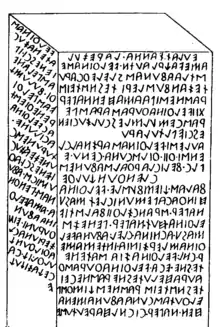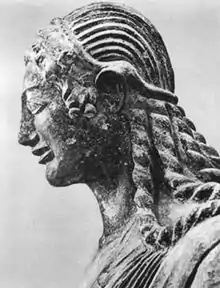


The Cippus Perusinus is a stone tablet (cippus) discovered on the hill of San Marco, near Perugia, Italy, in 1822. The tablet bears 46 lines of incised Etruscan text, about 130 words. The cippus, which seems to have been a border stone, appears to display a text dedicating a legal contract between the Etruscan families of Velthina (from Perugia) and Afuna (from Chiusi), regarding the sharing or use, including water rights, of a property upon which there was a tomb belonging to the noble Velthinas.[1][2][3]
The date of the inscription is considered to be 3rd or 2nd century BC. The Cippus is conserved in the National Archeological Museum of Perugia.[1]
Original text

Formatted according to latest theory by F. Roncalli for the original lines, distorted when they were copied onto this stone.[4] There are no capital letters in the original, but known and certain names are capitalized below. Lines in parentheses are those of the actual cippus. Word spacing is mostly hypothetical.
Front
- (1) eurat . tanna . La Rezu L /(2) ame vaχr lautn .
- Velθinaś e/(3)śtla Afunas sleleθ caru/
- (4) tezan fuśleri tesnś teiś /(5) raśneś ipa ama
- hen naper /(6) XII ( twelve ) Velθinaθuraś araś pe/(7)raśc
- emulm lescul zuci en/(8)esci epl tularu/
- (9) Aulesi Velθinas Arznal cl/(10)ensi . θii . θil
- ścuna . cenu e/(11)plc felic Larθalś Afuneś/
- (13!) falaś χiem fuśle Velθina /(12!)[...] clen θunχulθe/
- (14) hinθa cape municlet masu / (15) naper śran czl
- θii falaśt V/(16)elθina hut naper pen ezś/
- (17) masu acnina . clel . Afuna Vel/(18)θina mler
- zinia inte mame/(19)r cnl Velθina zia śatene/
- (20) tesne eca Velθina θuraś θ/(21)aura helu
- tesne raśne cei /(22) tesnś teiś raśneś
- χimθ śp/(23)el θuta ścuna Afuna mena /(24) hen
- naper ci cnl hare utuśe /...
Tentative translation
From van der Meer (following Facchetti and others) with some adjustments of word order:
- La(rt) Rezul, son of Lart was the arbitrator for this (case). The family (lautn)
- of Velthina took (caru) an oath (vaχr) along with one (member) from (the family) of Athuna.
- May they accept (fusle-ri?) (this) as property (tezan?) according to the Etruscan law (tesnś teiś raśneś), that (there) be
- 12 measures (naper) of (or "for"?) the Velthina (family), both moving (through it) and crossing (it) (araś peraśc?),
- (that is) in length and in width (emulm lescul), through our declaration (zuci enesci?), up to the place of (these?) boundary stone(s).
- As to Aule Velthinas, son of Arznei, (and) as to the water: He (Aule) may grant (ścuna) the (drawing) of water (θil)
- (which was) acquired (cenu), both for ep- and with the (appropriate?) price (feli?), by Larth Afuna.
- (As for?) the stake (falaś), Velthina [NAME's?] son, by covenant (θunχulθe), holds (cape) every property (χiem fuśle) behind it (i.e. the stake).
- In the sacred place, (there are) five measures (of land), their
- (extent stretching) between the water and the stake. Velthina may own (acnina) six measures next to five (?).
- Afuna may satisfy (mlerzinia) Velthina on these (things),
- about which (things) (he is) guarantor (mamer). Velthina disposes (śatene) these things (as is) right (zia).
- By law this tomb (is) the Velthina family's own tomb,
- through this Etruscan disposition according to the Etruscan law.
- In sum, (the agreement) allows only one carve out (śpel) (or 'exception'; literally 'cave' 'cavity'): Afuna may keep
- three measures (of land) here. Across these, he (may) enter (hare?)and lead (utuśe) (livestock)...[5]
Side
- (25)...Velθina ś/(26)atena
- zuc/(27)i enesci. i/(28)pa. śpelane/(29)θi. fulumχ/(30)va.
- śpelθi. /(31) reneθi. eśt/(32)ac Velθina /(34) acilune.
- turune. śc/(35)une. zea. zuc/(36)i. enesci. aθ/(37)umicś.
- Afu/(38)naś. penθn/(39)a. ama. Velθ/(40)ina. Afun(a) /(41)
- θuruni. ein /(42) zeriuna. cl/(43)a. θil. θunχ/(44)ulθl.
- iχ. ca /(45) ceχa. ziχuχ/(46)e
Tentative translation
Following van der Meer, as above:
- May Velthina order
- through our declaration (?) that as to the grotto, the sacred objects
- shall stay in the grotto at his disposal(?). And the same Velthuna shall do,
- give, and make good the right (things), through our declaration(?).
- The cippus (penthna) will be (the property) of the noble (athumicś) Afuna. Velthina will not prosecute (ein zeriuna) Athuna through (judicial) authority (thurune?). This is the accord concerning the water (rights),
- as it is written above.[5]
Notes
The last word in the text, ziχuχe means 'was written.'[6]
In line 10, θi-i and θi-l are respectively dative/instrumental and genitive for "water," and according to Facchetti (and approved by Wylin) the form cenu means "(is) obtained." Wylin translates the phrase (9-11) Aulesi Velθinas Arznal clensi/ θii θil ścuna cenu e/pl-c feli-c Larθal-ś Afun-e as "'With respect to the water of Aule Velthina, son of Arznei, the use (ścuna) of water is obtained bothepl and feli by Larth Afuna." And Wylin points out that the tricolon in lines 33-34 acilune. turune. ścune probably corresponds to the Latin legal phrase facere, dare, praestare "to do, to give, and to make good," a phrase used with respect to personal obligations rather than legal rights."[2][7][8]
Some phrases identified and partly translated by van Heems include: (1-2) eurat tanna larezul ame --"Larezul is the arbitrator tanna (of what follows?)"; (2-3) vaχr lautn Velθinaś eśtla Afunas slel eθ caru -- "An agreement of the Velthina tribe with that of Afuna, by his own (accord) was concluded (car-u ?)"; (3-5) tezan fuśle-ri tesnś-teiś raśneś -- "Complying (tezan ?) to the ordinances (fuśle-ri ?) from the public/Etruscan law"; (5-7) ipa ama hen naper XII Velθina-θur-aś araś peraś-c -- "that 12 hen (arable?) acres of Velthinas shall be dedicated and pera -ed." (18-21) inte mamer cnl Velθina zia śatene tesne, eca Velθina θuraś θaura helu --"To the (tomb) which Velthina zi-ed on the mamer according to the satena law, this has been hel -ed as the tomb of Velthina". In lines 29–30, the form fulumχva mirrors pulumχva in the Pyrgi Tablets and (in the singular?) pulum in the inscription on the Golini Tomb. (36-46)aθumicś Afunaś. penθna. ama. Velθina. Afuna θuruni. ein zeriuna. cla. θil. θunχulθl. iχ. ca ceχa. ziχuχe -- "The cippus of Afuna is aθumicś. Velthina (and) Afuna together (θuruni ?) shall not zerina (violate?) the accord concernting the water (rights), as this is written above."[9]
Notes
- 1 2 "National Archaeological Museum of Perugia - The Cippus of Perugia". Archived from the original on 2012-03-03. Retrieved 2021-07-15.
- 1 2 "The first Chapter of the Cortona inscription" (PDF). Archived from the original (PDF) on 2010-06-13.
- ↑ Jean MacIntosh Turfa (13 November 2014). The Etruscan World. Routledge. pp. 363–. ISBN 978-1-134-05523-4.
- ↑ Hillary Becker "Evidence for Etruscan Archives: Tracking the epigraphic habit in tombs,the sacred sphere, and at home" in Etruscan Literacy in its Social Context ed. Ruth Whitehouse, Accordia Research Institute, London, 2020. p. 172-4. https://air.unimi.it/bitstream/2434/722285/2/BagnascoGianni%202020-deGrummond.pdf
- 1 2 Van der Meer, L. B. (2017) "Some Reflections on the Inscription of the Cippus Perusinus" Sudi Etrusci vol. 80, p. 204
- ↑ Bonfante, L. Reading the Past: Etruscan. UCalPress. !990. p12
- ↑ Facchetti, Giulio M. Frammenti di diritto privato etrusco. Firenze. 2000
- ↑ "Definition of PRAESTARE". The Law Dictionary. 12 July 2014. Retrieved 6 April 2023.
- ↑ Gilles van Heems, "Per uno studio sintattico del Cippo di Perugia: struttura frastica e fraseologica di un 'testo lungo'" in Mélanges de l'École française de Rome - Antiquité 133.1, 2021, pp. 23-38. https://doi.org/10.4000/mefra.11136. https://journals.openedition.org/mefra/11136 Open Access
References
- Materials for the study of the Etruscan Language prepared by Murray Fowler and Richard George Wolfe.
- Belfiore, V. (2017) "Per una revisione del testo del Cippo di Perugia," in Studi Etrusci, 80, p. 167-200.
- Belfiore, V. (ed.) (2021) Il cippo di Perugia. Vecchi problemi e nuove letture, Atti dell'Incontro di studio, Perugia, Museo Archeologico Nazionale, 15 febbraio 2019, MEFRA 133.1.
- Benelli, E. (2021) "Il cippo di Perugia come documento storico. Stato delle conoscenze e problemi connessi," in: V.Belfiore (ed.), Il cippo di Perugia. Vecchi problemi e nuove letture, Atti dell'Incontro di studio, Perugia, Museo Archeologico Nazionale, 15 febbraio 2019, MEFRA 133.1, pp. 13–21.
- Bonfante, Giuliano; Bonfante, Larissa (2002). The Etruscan Language: an Introduction. Manchester, University of Manchester Press. ISBN 0-7190-5540-7.
- Cristofani, Mauro; et al. (1984). Gli Etruschi: una nuova immagine. Firenze, Giunti Martello.
- Cristofani, Mauro (1979). The Etruscans: A New Investigation (Echoes of the ancient world). Orbis Pub. ISBN 0-85613-259-4.
- Facchetti, G. M. (2000) Frammenti di diritto privato etrusco, Firenze.
- Grünwedel, A. (1922) Tusca. 1. Die Agramer mumienbinden. 2. Die inschrift des cippus von Perugia. 3. Die Pulena-rolle. 4. Das bleitäfelchen von Magliano. 5. Die leber von Piacenza. 6. Golini-grab I. 7. Die inschrift von Capua. Leipzig : K. W. Hiersemann
- Hadas-Lebel, J. (2021) "La parola tezan sul Cippo di Perugia", in: V.Belfiore (ed.), Il cippo di Perugia. Vecchi problemi e nuove letture, Atti dell'Incontro di studio, Perugia, Museo Archeologico Nazionale, 15 febbraio 2019, MEFRA 133.1, pp. 53–58.
- Manthe, U. (1979) "Ein etruskischer Schiedspruch. Zur Interpretation des Cippus Perusinus," in Revue internationale des droits de l'antiquité, 26, 1979, p. 261-305.
- Massarelli, R. (2016-2020) "Perusii nominant litteras etruschas. Una nota sulla prima documentazione epigrafica etrusca da Perugia," in Symbolae antiquariae, 9, pp. 39–47.
- Massarelli, R. (2001) "Tezan tra Cippo e altra documentazione," in: V.Belfiore (ed.), Il cippo di Perugia. Vecchi problemi e nuove letture, Atti dell'Incontro di studio, Perugia, Museo Archeologico Nazionale, 15 febbraio 2019, MEFRA 133.1, pp. 59–73.
- Pallottino, M. (1948-1949) "Sulla lettura e sul contenuto della grande iscrizione di Capua," in Studi Etrusci, 20, pp. 159–196.
- Pfiffig, A.J. (1961) "Untersuchungen zum Cippus Perusinus" in Studi Etrusci, 29, pp. 111–154.
- Rigobianco, R. (2021) "I dimostrativi nell'incipit del testo etrusco del Cippo di Perugia. Considerazioni linguistiche ed ermeneutiche," in: V.Belfiore (ed.), Il cippo di Perugia. Vecchi problemi e nuove letture, Atti dell'Incontro di studio, Perugia, Museo Archeologico Nazionale, 15 febbraio 2019, MEFRA 133.1, pp. 39–51.
- Rix, Helmut (1985) "Sul testo del 'cippo di Perugia'" in Studi Etruschi 53 [1987], pp. 161–170.
- Rix, Helmut (1991). Etruskische Texte. G. Narr. ISBN 3-8233-4240-1. 2 vols.
- Tassi Scandone, E. (2021) "Il cippo di Perugia e i communalia etruschi. Note sugli statuti legali delle terre comuni nell'Italia antica," in: V.Belfiore (ed.), Il cippo di Perugia. Vecchi problemi e nuove letture, Atti dell'Incontro di studio, Perugia, Museo Archeologico Nazionale, 15 febbraio 2019, MEFRA 133.1, pp. 85–95.
- Van Heems, G. (2001) "Per uno studio sintattico del Cippo di Perugia. Struttura frastica e fraseologica di un 'testo lungo'," in: V.Belfiore (ed.), Il cippo di Perugia. Vecchi problemi e nuove letture, Atti dell'Incontro di studio, Perugia, Museo Archeologico Nazionale, 15 febbraio 2019, MEFRA 133.1, pp. 23–38.
- Van der Meer, L. B. (2017) "Some Reflections on the Inscription of the Cippus Perusinus" Sudi Etrusci vol. 80. pp. 201–204. DOI: 10.26406/StEtr80-013.
External links
- The Etruscan Texts Project A searchable database of Etruscan texts.
